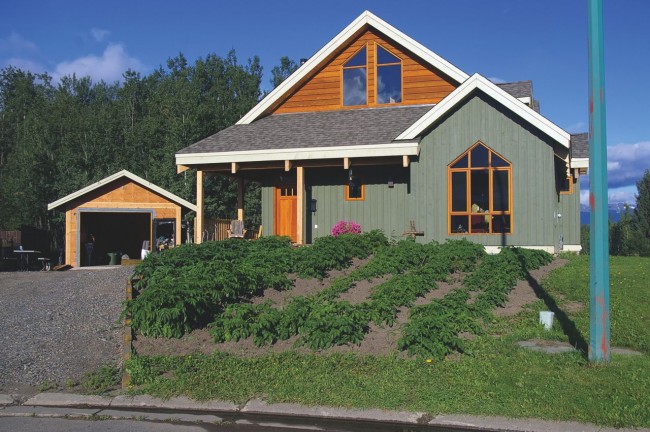
Growing Community in Front-Yard Gardens
One of the best things Barak Obama ever did was turn over some of the White House lawn to plant some spuds. Producing healthy food, working together as family, and emphasizing local food production were some of the values the Obamas were modelling.
For many people today, vegetables are something for grocery stores, backyards or perhaps patios. But not the front yard, the domain of the lawn. Things could be different, however. During World War II, citizens measured each other’s patriotism by the presence of their Victory Gardens. US citizens were encouraged to grow vegetables instead of grass in the front yard, between sidewalk and curb, or wherever they had space.
Front-yard gardens are not something all that new. You can find them in villages all over Eastern Europe, and elsewhere. And they existed in Canada, too.
Before I could even find Edmonton on the map, I heard from Albertan classmates at my college in the US about the large population of Ukrainians there. “They plant potatoes and cabbages in their front yards for a few years to get the soil in shape to plant a lawn,” was the explanation I heard. But I expect those Ukrainian-Canadians planted front-yard gardens for other reasons. Perhaps because landscaping in their homeland had different patterns than the small front “garden”—a bit of grass and some perennials—that English-Canadians inherited. Or because they ate lots of potatoes and cabbage rolls. Or because they simply had good sense.
Serving up community
Meanwhile, in countless cities and towns across Canada, community gardens are springing up. In Prince George, Dr. Scott Green of UNBC has been influential in trying to establish not only the gardens themselves, but a consciousness of the community-building value of gardens.
One of the projects is located on the property of the Prince George Christian Reformed Church. Members of the congregation see their involvement as a way to serve the local community. The garden is not fenced and is visible and accessible to pedestrians. It invites walk-through traffic, and communication and interaction.
One June day as I walked through Smithers I noticed a lilac bush hanging over a board fence. Tacked to the fence was a note: PLEASE HELP YOURSELVES. Sharing blooms and nature’s bounty were clearly valued by the residents of that home.
Residents in apartment buildings may have fewer front-yard gardening opportunities, but gardening and good-food guru Gail Jenne has been doing something to change that. At Princess Gardens in Smithers, a fenced, formerly vacant lot is now a productive community garden serving residents of nearby apartments. By a stroke of genius and respect, Jenne arranged to have sweet peas planted on the inside of the fence, making them accessible for smelling and picking by sidewalkers and residents of the nearby Bulkley Lodge, who can benefit from the flowers on their late-summer walks and wheelchair rides.
Perhaps we all need to do a little horticultural dreaming. Last summer a resident of the Bulkley Lodge in Smithers set out a big potted tomato right at the entrance. It made me wonder: Why don’t retirement homes and nursing homes have vegetable gardens? Steffen Meyer of Quick has made raised gardening beds from 2×10 lumber that are high enough for weeding while standing. Why couldn’t we do the same for our wheelchair friends? A donation of cement for permanent paths, some donated lumber and labour, and all sorts of good things could happen.
Living local
John and Betty Siebenga of Houston had a front-yard garden last summer. Their potato patch is part of their way of life that shaped the construction of their house, their hobbies, and their community vision.
The Siebengas planned their house with care. With clean lines, lots of light and lots of wood, it is a beautiful house. They also planned according to their convictions. They wanted to use local materials whenever possible, and in their part of the province that means wood. The post-and-beam structure uses Douglas fir beams from near Babine Lake, the closest source.
Much of the rest of the house uses lodgepole pine, the species that has been decimated by the mountain pine beetle. After the beetle bores, a fungus invades the wood and leaves a bluish stain. The wood, considered marred by some, is lauded by others as “denim wood.” All the pine in John and Betty’s house is made of this local resource.
The cabinets are not just any cabinets, but are produced by local craftsman Roland Oberlader of Quick, who learned his trade in Austria.
When John, a school principal, began the serious woodwork, he hired a student as a summer helper, providing money for the student plus valuable training. Lifting the beams required a small crane, which the Siebengas rented from a local logging contractor who had machinery available during off-time in the forest.
All in all, it is a beautiful house, an ethically-conceived house, and—if you should be so fortunate to visit—a haven of hospitality. You might even get some honey from the hives John keeps in the backyard, or wine made by Betty from local crab-apples, currants and saskatoons.
By spring of 2011 the Siebenga’s house was mostly completed, but there remained the matter of the front yard of packed clay. One reached the front door on boards, which were utilitarian but rather ugly.
By last August, however, you could see a front yard covered with healthy potato vines. Even in a small town where gardens are still the norm rather than the exception, people would stop and stare. Actually, people seem to go out of their way to go up the cul-de-sac, and stare. “Betty and I are always amazed about the people who do drive-bys,” John says. “I do wish they would stop and come in. It gives us an excuse to drop our hammers, our rakes and other tools and take a break!”
The Siebengas are people who value neighbourliness, and their potato patch is a way of practising that value.
Famous front yards
Wouldn’t it be wonderful if Canadians planted Neighbour Gardens in their front yards instead of lawns, and dedicated the food produced there to a local food bank or soup kitchen? And wouldn’t it be great if people drove or walked around our subdivisions, our churches, our courthouses and government offices, gawking at all the vegetable gardens? Wouldn’t it be wonderful if pedestrians, bikers, and home-owners spent time talking together over freshly-turned soil, early peas, or even insect problems in the cool of our evenings?
Better still, wouldn’t it be quite a statement if Canadians were known by their front yards? If gardens became a “brand” by which Canadians were known? If food-for-the-hungry were a visible part of Canadian lifestyle? If yards and vacant lots invited people into each other’s lives?
We have a good example in John and Betty’s home and yard. What’s stopping the rest of us from thinking about our neighbourhoods while we plan our gardens?



